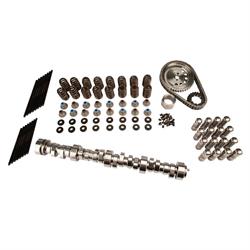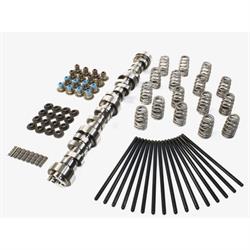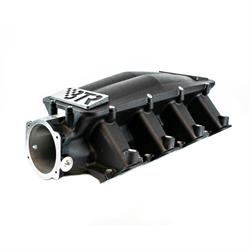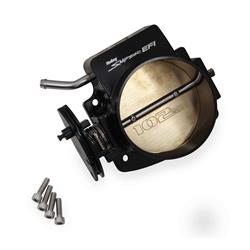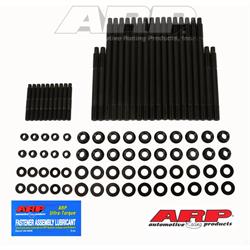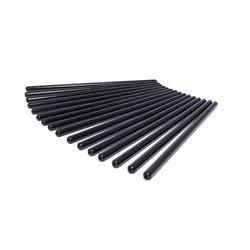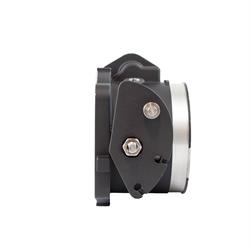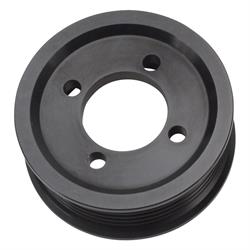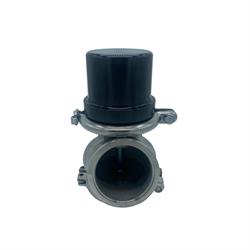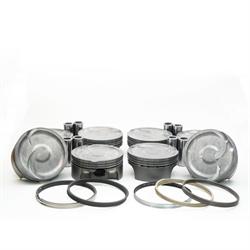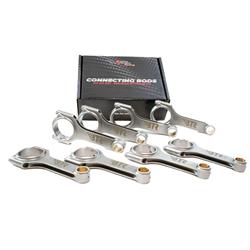LQ4 Engine Build Upgrades | Recipes for 500HP - 1,000HP
Is an LQ4 an LS motor?
GM’s three character engine codes can often be confusing to enthusiasts. Especially when the General opts to reuse them from one engine generation to another, such as the LT1 (or LT-1 for you classic Gen 1 SBC fans). Just what is a LQ4 engine anyway? Well, we’ll put your mind at ease by confirming, yes, it is indeed part of the LS engine family, specifically the Gen 3 LS family. While it does not use “LS” in its engine code like other LS-based V8 engines, the LQ4 shares the same basic architecture, core design, and many of the same internal and external components with its other Gen 3 family members, making a LQ4 engine swap no more difficult than the typical 4.8 or 5.3 LS swap. Even the LQ4 valve covers are standard LS fare and can be upgraded with any manor of aftermarket LS-based valve covers.
The 6.0 LS engine LQ4 was produced from 1999-2007 for GM’s truck, SUV, and van applications, such as the Silverado, GMC Seirra, Suburban, and more. These LQ4 years share the engine block design, cylinder head bolt pattern, and reciprocating assembly and valvetrain layout of the Gen 3 LS1 and LS6. This compatibility makes the LQ4 popular for budget swaps or the basis for high horsepower builds, as many prefer the cast iron LQ4 engine block of the truck applications versus the aluminum block found in car applications. With 6.0L of displacement and officially given the name of Vortec 6000 in truck applications for marketing purposes. Generally, you will only find the “Vortec” name on the intake plenum cover and not any engine hard parts. Learn more about Vortec vs LS in our Vortec vs LS engine guide. While similar, don’t confuse the LQ4 Vortec for the higher output LQ9. The main difference between LQ44 and LQ9 engines is that the LQ9, also known as the Vortec HO 6000 or VortecMAX is the higher compression (10:1) flat top pistons. This makes the LQ9 a great N/A offering, but if going for boost, the LQ4’s 9.4:1 compression is better suited. The difference in LQ4 engine horsepower vs the LQ9 is only 20 hp, so it’s not like the LQ9 is really worth it.
GM LQ4 Engine Specs:
- 6.0-liter displacement
- Cast iron block
- Aluminum or cast iron cylinder heads depending on the model year
- 9.4:1 compression ratio
- Horsepower rating: 300 to 330 depending on the application
- Torque rating: 360-370 ft-lb depending on the application
LQ4 Engine Specs | How Much Horsepower Does a Factory LQ4 Have?
As the Chevy LQ4 engine application was truck/SUV based, the engine favored torque production over pure horsepower. Though 300 horsepower was actually quite respectable in the early 2000s, it was the torque that the LQ4 produced that helped GM’s truck and SUV products, especially when loaded down or towing. There were, however, differences in output of both horsepower and torque depending upon model year and application. We’ve provided common Chevy LQ4 engine specs and what model years/applications were fitted with the LQ4 in the chart below.
How Much Power Can a 6.0 LQ4 Handle?
Are we talking stock or modified when asking about how much power can a LQ4 handle? Stock, the limiting factor is going to be the rotating assembly and not the block. The cast iron block is quite stout and is known for its strength and ability to support big power upgrades. So, when it comes to a stock LQ4 snatched right from the engine bay of that Silverado you found in the salvage yard, we’re talking about 500 to 550 horsepower with a proper and safe tune and bolt on supporting components. This means a good cam, intake, throttle body, and head work or aftermarket heads. Now drop a forged rotating assembly into that same block (especially a stroker kit) and add some boost via a turbo kit or supercharger and you can make four-digit horsepower with the stock cast iron LQ4 block.
Stock Bottom-End Limitations and Known Weak Points:
- The stock rotating assembly, which includes cast pistons, powdered metal rods, and a cast crankshaft, is generally safe up to 500 to 550 horsepower at the crank with a good tune.
- Factory pistons are cast and have thin ring lands, making them a weak link under high boost or heavy nitrous.
- Rod bolts are torque-to-yield and not ideal for high-stress applications without replacement.
- Stock valvetrain can float valves at higher RPMs if not upgraded.
- With boost or nitrous, many tuners and builders recommend keeping power around 450 to 500 rear-wheel horsepower to maintain long-term reliability.
Recommended upgrades to safely exceed the 550 hp range:
- Forged pistons and rods to replace the weaker factory components.
- ARP rod bolts and main studs for added bottom-end strength.
- Upgraded head gaskets and head bolts or studs to handle increased cylinder pressure.
- Stronger valvetrain components if running higher RPMs or more aggressive cams.
- Improved fuel system and tuning to keep air/fuel ratios in check and prevent detonation.
Does The LQ4 Have Cathedral Port Heads?
Yes, the 6.0 LQ4 engine uses the widely popular early LS cathedral port style of cylinder head. Whether you’re looking at early iron heads (casting numbers 373 and 873) or the later and more common aluminum 317 heads (casting numbers 317 and 035), all LQ4 GM engine variants feature cathedral-style intake ports. These heads are part of what makes the LQ4 compatible with many other Gen III LS parts, including aftermarket intakes and camshaft upgrades. Cathedral ports were standard on most early LS engines and are still widely used in a LQ4 performance build due to their responsiveness and tuning flexibility. To learn more about the various LS head designs, valve sizes, and casting numbers be sure to check out the LQ4 heads listed in our Best LS head guide elsewhere in The Toolbox.
Pros:
- Cathedral port design offers strong midrange torque and throttle response.
- 317 heads have large intake runners (210cc) and generous combustion chambers (71cc), ideal for boost or nitrous builds.
- Widely available and budget friendly in the used parts market.
- Fully compatible with most Gen III and Gen IV LS valvetrain and intake upgrades
Cons:
- Large combustion chambers lower compression when used on smaller displacement engines.
- Not as high flowing as later LS rectangular port heads (like those found on LS3 engines).
- Heavier than performance focused aftermarket heads, especially early iron castings.
LQ4 Cylinder Head Specs:
- Years: 1999-2007
- Casting Numbers: 373, 873 (1999–2000); 317, 035 (2001–2007)
- Material: Iron (1999–2000), Aluminum (2001–2007)
- Combustion Chamber Volume: 71cc
- Intake Port Shape: Cathedral
- Intake Runner Volume: 200cc (Iron), 210cc (Aluminum)
- Exhaust Port Shape: Oval (Iron), D-Port (Aluminum)
- Exhaust Runner Volume: 70cc (Iron), 75cc (Aluminum)
- Intake Valve Diameter: 2.000 in.
- Exhaust Valve Diameter: 1.550 in.
- Cylinder Head Bolt Style: Factory torque to yield (TTY)
- Cylinder Head Bolt Size (1999–2003): (8) M11 x 2 x 155, (2) M11 x 2 x 100, (5) M8 x 1.25 x 45
- Cylinder Head Bolt Size (2004–2007): (10) M11 x 2 x 100, (5) M8 x 1.25 x 45
LQ4 Engine Budget Rebuild Kit
The fact is that if you’re going to grab a 6.0 LQ4 engine from the salvage yard for your LS swap you must remember the newest engine available is going to be from 2007. At the time of this writing that’s an 18-year-old engine and it most likely is sitting north of 100K miles on the odometer with no way to verify just how well the owner (or owners!) has taken care of it. Did it see regular oil changes and low rpm family cruising? Or is it a victim of extended drain intervals or “I’ll get around to that oil change soon” maintenance and towed a 6,000 pound trailer every day? There’s really no way of knowing without cracking the engine open and doing some inspection. As such, you’re going to have to factor in some rebuild components to freshen that 6.0L LQ4 up before it goes down on your mounts. Will it need gaskets and seals and maybe drop a nice cam in it? Or will it need bearings, oil pump, other major parts? You just don’t know until you get inside. Below we’ll cover the most common LQ4 engine parts you’ll need to look at for a budget LQ4 build. You might get lucky and find an LQ4 engine rebuild kit, but most likely you’ll have to piece your needs together based on what you find when you crack your engine open. Will you need them all? Hopefully not!
Most Important LQ4 Engine Parts to Replace Based on Mileage and Maintenance Needs
- Piston rings: These commonly wear out over time, causing compression loss and oil consumption. Replace if the engine has high mileage, low compression, or excessive oil burning.
- Pistons: With higher mileage used engines there is a chance you’ll need to overbore the block to get the cylinders back in spec, which will require oversized replacement pistons.
- Main and rod bearings: Bearings wear with use and can lead to engine knock or failure if neglected. Replace if there are signs of bearing wear, knocking sounds, or metal shavings in the oil.
- Connecting Rods: In extreme cases of wear, or if you’re looking for stronger internal parts for performance, new connecting rods might be a consideration as well.
- Rear main seal and front crankshaft seal: These seals often leak as they age, leading to oil loss. Replace if there is visible oil leaking from the rear or front of the crankshaft area.
- Timing chain and components: These can stretch or wear out, causing poor timing and noise. Replace if there is excessive timing slack, rattling noises, or high mileage.
- Valve stem seals: Worn seals can allow oil to enter the combustion chamber, causing smoke and oil loss. Replace if the engine smokes on startup or burns oil.
- Oil pump: A worn oil pump can result in low oil pressure and poor engine lubrication. Replace if the engine has high mileage or shows signs of low oil pressure at idle or under load.
- Replacement gaskets: Depending upon how far into the engine you go, you may need specific replacement gaskets, such as head gaskets, intake gaskets, and more.
Best Bolt-On LQ4 Upgrades
While the LQ4 6.0L LS can be built to make serious horsepower, this Gen 3 engine most certainly can churn out respectable performance with the proper combination of bolt-on parts. Keeping your 6.0 LQ4 build recipe to bolt-on components not only keeps your budget in check, but also means you can do the work yourself, often right where the engine sits in the engine bay. There’s no need to fully disassemble the engine, involve a machine shop, and deal with any internal rotating assembly upgrades. The bolt-on LQ4 engine upgrades route will often provide 400 plus horsepower (at the crank), which will no doubt provide miles of smiles every time you hit the throttle. These are easy LQ4 upgrades that are effective and stock bottom end (SBO) friendly. Need more for your LQ4 6.0 build? That’s just an LQ4 408 stroker build, turbo, or supercharger upgrade away!
Best Bolt-On LQ4 Upgrades (Stock Bottom End Friendly):
- Intake Manifold and Throttle Body Upgrade: The factory truck intake is designed for low-end torque but restricts airflow at higher RPMs. Upgrading to a higher-flow LQ4 intake manifold and larger throttle body can improve top-end horsepower and overall engine breathing.
- Long Tube Headers and High-Flow Exhaust: Factory exhaust manifolds are restrictive. Replacing them with long tube style LQ4 headers and a less restrictive exhaust system increases horsepower, torque, and throttle response.
- Cold Air Intake: A cold air intake improves airflow and reduces intake temperatures. This helps increase horsepower and supports future upgrades.
- Electric Fan Conversion: The mechanical fan draws power from the engine. Switching to electric cooling fans reduces parasitic loss, freeing up additional horsepower and improving fuel economy, not to mention will be required with most LS swaps due to the smaller engine compartment.
- Camshaft Upgrade (mild performance cam): The stock camshaft limits power potential. A mild performance LQ4 cam kit compatible with the stock bottom end can add significant horsepower and torque when paired with proper tuning.
- Valve Springs and Pushrods: A cam upgrade requires stronger valve springs and pushrods to handle increased lift and RPMs. This ensures safe and dependable valvetrain performance.
- Cylinder Heads (ported, larger valves, or higher compression): Porting stock heads or swapping to heads with smaller combustion chambers and/or larger valves can improve airflow and raise compression. This results in better efficiency and more power.
- Custom ECU Tune: Tuning is essential after installing bolt-on upgrades. A custom ECU calibration maximizes performance, improves drivability, and ensures the engine runs safely with new components. This is true be it stock EFI or aftermarket EFI solutions.
- Larger Fuel Injectors (if needed): Airflow increases from bolt-ons may exceed the stock injectors' capacity. Upgrading to larger LQ4 injectors ensures proper fueling and supports higher power levels.
- High-Flow Fuel Pump: A higher-capacity fuel pump helps maintain consistent fuel pressure when horsepower increases, especially when paired with upgraded injectors.
500 HP LQ4 Build
Notes: We highly recommend adding these additional items to your build list:
550 HP LQ4 Build
Notes: We highly recommend adding these additional items to your build list:
600 HP LQ4 Build
- Flo-Tek LS3 Cylinder Head (order two quantity
- BTR Equalizer 3 Intake Manifold
- FAST 65 lb/hr Injectors, Set of 8
- Comp Cams Stage 2 LS3 Hydraulic Roller Cam
- BTR Platinum Dual Valve Spring Kit
- Holley 102mm LS Throttle Body
- ARP 2000 LS Head Stud Kit
- Speedway Motors Premium LS Engine Gasket Kit
- Chevrolet Performance Parts Harmonic Balancer Bolt
Notes: We highly recommend adding these additional items to your build list:
If you do not have a throttle body to transfer IAC and TPS sensors you can substitute the FiTech 102mm throttle body for the Holley one listed, as it comes complete.
700 HP LQ4 Build
Notes: We highly recommend adding these additional items to your build list:
800 HP LQ4 Build
- VS Racing VSR-400 80mm Turbo
- Hooker Single Turbo Exhaust Manifold Kit
- Flo-Tek LS3 Cylinder Head (order two quantity
- BTR Equalizer Intake Manifold
- Comp Cams LST Series Stage 2 Cam
- BTR Dual Valve Spring Kit
- VS Racing 50mm Turbo Wastegate
- FAST 85 lb/hr Fuel Injectors/Set of 8
- Holley Sniper 102mm Throttle Body
- ARP 2000 LS Head Stud Kit
- LS Engine Gasket Set
- GM Balancer Bolt
Notes: We highly recommend adding these additional items to your build list:
1,000 HP LQ4 Build
- VS Racing VSR-400 80mm Turbo
- Flowtech LS Turbo Headers
- Flo-Tek LS3 Cylinder Head (order two quantity
- BTR Equalizer Intake Manifold
- Comp Cams LST Series Stage 2 Cam
- BTR Dual Valve Spring Kit
- VS Racing 44mm Turbo Wastegate (order two quantity)
- FAST 85 lb/hr Fuel Injectors/Set of 8
- Holley Sniper 102mm Throttle Body
- ARP 2000 LS Head Stud Kit
- LS Engine Gasket Set
- GM Balancer Bolt
Notes: We highly recommend adding these additional items to your build list:
LQ4 Turbo Build For Boost
When considering a single or twin turbo 6.0 LQ4 turbo build, the preferred starting point is using an iron block-based LS engine for your LQ4 boost build. This makes the LQ4 a great starting point, as it is a relatively cost effective option to source used and the factory iron block is a welcome bonus for boosted applications. The block itself is strong enough to handle four-digit horsepower, but you’ll certainly need to upgrade the rotating assembly and other hardware to get to that power potential with any modicum of reliability. Building a high horsepower turbocharged LS engine isn’t a low budget effort, but scattering your crank and rods all over the track or street is pretty much the alternative with lots of boost and stock bottom end builds.
We’ll start with the obvious when doing an LQ4 build for boost, which is the rotating assembly. For high boost applications that stout iron block requires an equally stout crank, rods, and pistons. The stock crank will handle a good amount of horsepower for a budget LQ4 turbo build, but the powdered metal rods, and pistons all need to be swapped out for strong, forged versions. The stock bottom end is typically good for low 500s horsepower wise or roughly 10 psi of boost, but forged pistons and rods will keep things safe above that and to about 800 horsepower and 15 psi of boost. Again, moving north of that into four-digit power numbers a better crank will need to be added to your LQ4 twin turbo build shopping list. With this level of upgrade, we obviously can’t forget things like high quality fasteners for the main and rod caps, head studs, and high quality MLS head gaskets to keep all that boost pressure inside the combustion chamber.
With the short block beefed up you’ll need to top things off with a solid pair of heads (stock with some porting or high flow aftermarket), a turbo friendly camshaft with supporting bits like trunnion upgrade kit and roller rockers, and a suitable intake. For high boost it is suggested to go with an aluminum intake versus plastic. A larger fuel system will be necessary as well, including larger injectors, fuel pump, and a boost-referencing fuel pressure regulator. The final two pieces of the puzzle are tuning (either custom tuning of the stock PCM or aftermarket tunable EFI conversion), and of course the turbo bits (do you go single or twin turbo?) that make up a complete turbo build. These include the turbo itself, turbo headers/manifolds, hot and cold side plumbing, boost controller, intercooler, wastegate(s), and blow off valve(s). Often, you can find much of these parts in an LQ4 turbo kit, saving you time and money when shopping.
LQ4 Supercharger Build
Much like a turbocharged build, adding an LQ4 supercharger system to the iron block 6.0L LQ4 engine is a great option. Superchargers tend to trade installation ease for cost, so while superchargers generally cost more, they are much easier to install than the typical turbo system. Additionally, most superchargers provide strong low end torque while most turbo systems begin to pull harder at mid to upper RPMs, making the supercharged route the best option for a LQ4 torque build for street use. Much like the turbo build mentioned above, going the supercharged route with your LQ4 LS engine will take additional supporting components depending on the boost level you are aiming for.
An entry level supercharger kit is usually set up to provide between six and nine pounds of boost. This will be good for up to about 600 horsepower. While you’ll be close to the “edge” on the LQ4’s pistons and rods, with proper tuning and adequate fuel system upgrades, it will work just fine. However, as we all know, more boost is just a pulley swap away on a supercharger system and dropping that pulley size down only takes a few minutes, but you better have the hardware support (forged internals) to go along with that 15 or more PSI that new pulley is going to provide you with. This also includes quality fasteners and gaskets to keep the boost pressure where it belongs. Much like the turbo build a good fuel system, boost friendly cam, and other upgrades will make the most of the supercharger addition. Depending on the supercharger style (roots, centrifugal, etc.) it may utilize an air-to-air or air-to-liquid intercooler or not come with one at all. Adding one and its associated plumbing is an additional cost consideration. If you’re undecided about how you plan to add boost, perhaps check out our LS turbo vs supercharger guide in our Toolbox.
What Vehicles Have an LQ4 Engine?
The LQ4 engine is GM’s iron block “workhorse” Gen 3 LS engine, which can be found in trucks, SUVs, and vans from 1999-2007. This means that these engines are usually plentiful for LS swap needs from various outlets. Below we’ve listed year-by-year applications to aid in your search and confirmation of LQ4 fitments.
But where to find these trucks and SUVs for the picking? The most common source is going to be your local salvage yard. You can usually find LQ4 powered trucks easily going this route (confirm the 8th digit of the VIN is the letter U). Some yards will offer packages with the LQ4 engine and transmission, along with wiring/PCM for your LS swap, while others will simply sell everything piecemeal, allowing you to buy only what you need (no sense spending your hard earned funds on a 6L80 if you’re planning a manual trans behind your LS swap). Confirm the junkyard LQ4 by the casting numbers and model and year of the donor vehicle. Another option is going to be online marketplaces like Craigslist and Facebook Marketplace, as well as eBay and other outlets. Here you might pay a little more, but the LQ4 engine you’re searching for will most likely already be removed and ready for pickup. Often the seller still has the vehicle the LQ4 came from, and you may be able to procure additional components for your LS swap.
Additional resources include engine rebuilders and performance shops as well as completely new crate engine offerings. Performance shops may have an LQ4 donor that they ended up not needing for a project, or perhaps a customer’s LQ4 build that was never paid for and the shop is simply trying to recoup some of their expenses. The same can be said for engine rebuilders. If you have a local performance shop or engine rebuilder it is worth the visit or call to see what they may have on the shop floor that they need to get rid of. You may even be able to work with these shops on your build or take over an incomplete or abandoned LQ4 build project and make it your own. You never know unless you reach out to them. There are plenty of LQ4 crate engine options as well if you’re simply looking for an all new engine ready to drop down on your LS swap mounts and not looking to deal with machine shop wait times and figuring out all the details of a full LS engine build.
Lastly, there are the good old swap meets and major car shows. Attending these you never know what you might stumble upon. There are often vendors selling takeout LS engines, accessories, and more to help you with your LS swap. At major events like Goodguys, LS Fest, and NSRA shows you will also be able to chat with manufacturers to help answer your build questions and possibly score bundle deals like engine, ECU, engine mounts, accessory drive, and more. So, don’t count the old fashioned face to face wheelin’ and dealin’ of a swap meet, as it is still a viable option for solid finds you’ll need for your LQ4 engine-based LS swap.
Technical content assistance provided by Jerad Flemming
